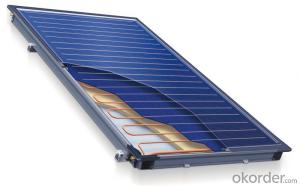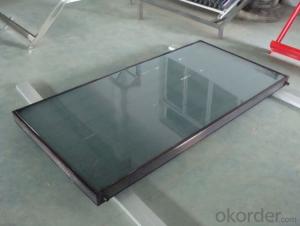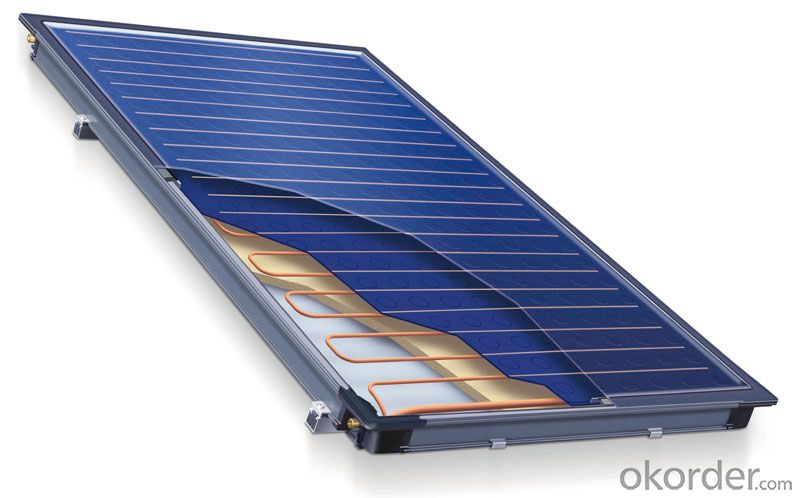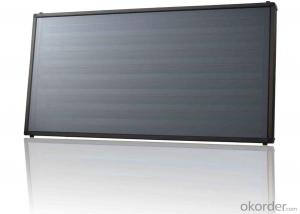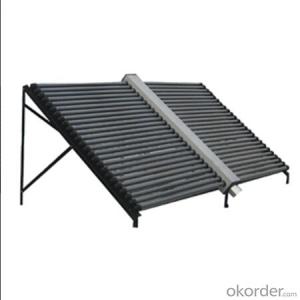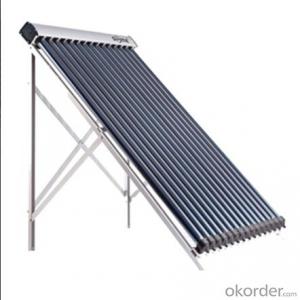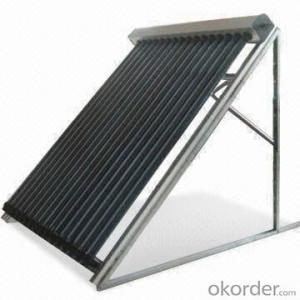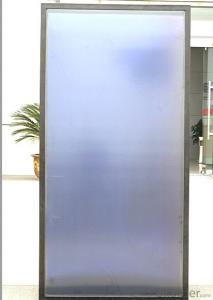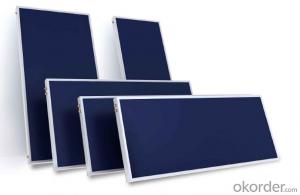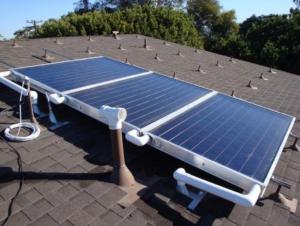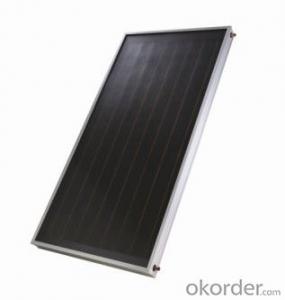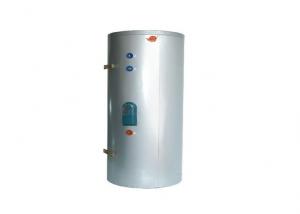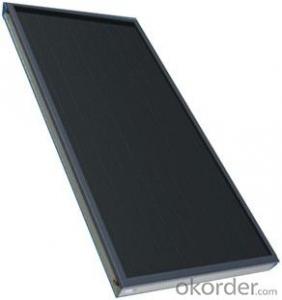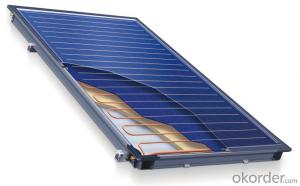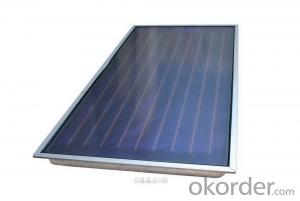Flat-Plate Solar Collectors - Separated Flat Plate Solar Thermal Collector
- Loading Port:
- Shanghai
- Payment Terms:
- TT OR LC
- Min Order Qty:
- 500 pc
- Supply Capability:
- 10000 pc/month
OKorder Service Pledge
OKorder Financial Service
You Might Also Like
Specifications
Sunshore non pressure solar collector
CE, Solar keymark certificate
Low pressure, high efficiency. low cost
Commercial use
Sunshore vacuum tube non pressure solar collector
Detail of material:
Outer tank: Al-Zn coated steel sheet
Inner tank: SUS 304-2B stainless steel sheet
Insulation: Polyurethane foam
Vacuum tube: Borosilicate glass 3.3
Absorption coating: Al-N-Cu-SS
Stand: Aluminum Alloy/Galvanized sheet
Feature of Flat Plate collector:
1.using patent advanced coating technology with high efficiency performance
2.High strength aluminium-alloy structure with surface varnish baking
3.High visual shape, easy installation, maintenance free
4.Pressurized designing, operate with pressure up to 1 MPa
5.Can be combined with existing energy
Features:
Copper pipes and fins
Blue Vacuum Coating
American ultrasonic welding
Tempered glass cover
Size: 2000*1000*90mm
Advantages:
Great pressurization property, very safe and clean.
Absorption ≥95%; emission ≤5%.
Strong thermal stability.
Strong welding property and conductivity.
Strong protection to the collector.
Benefits:
Durable and corrosion-resistant material makes your maintenance cost low.
Comfortable hot water can be gained even in medium solar radiation areas.
Increases the value of your property.
Long lifespan to 25 years, makes your investment more worth it.
Worry-free from hails or other terrible weathers.
Product advantage
Solar energy (Solar) generally refers to the Sun's radiant energy which is used as the modern general power generation. The water tank adopts stainless steel SUS304 food grade material, Corrosion resistance and durable .The brackets Using aluminum alloy material,USES the word "people" streamlined support, and combine the water tank, strong and durable .The vacuum tube is made of high quality high borosilicate, hard glass production,Good light transmittance,Heat faster Heat preservation is better. Our company can produces its own water tank bracket and vacuum tubes,Its products over the years committed to technology innovation,So the quality and service guaranteed and there are quite a preferential price.So many advantages is your best choose!
How it works
The design of this type uses the all-glass evacuated solar collector tubes as the heat absorb element. The high vacuum degree of the clearance between the outer and inner tube can reduce the heat emission which caused by convection and conduction to a very low level. All-glass evacuated tube transfers sun energy into heat energy by high absorption rate and low emittance rate of layer films. Depend on the different density between the hot water and the cold water, a cycle created in the tube which hot water ascending and cold water descending status. Keeping natural circulation like this, the water in the tank will be heated. Flat plate collectors are an extension of the basic idea to place a collector in an 'oven'-like box. Here, a pipe is connected to the water tank and the water is circulated through this pipe and back into the tank. The water tank is now outside the collector that only contains the pipes. Since the surface-to-volume ratio increases sharply as the diameter of a pipe decreases, most flat-plate collectors have pipes less than 1 cm in diameter. The efficiency of the heating process is therefore sharply increased. The design of a flat-plate collector therefore typically takes the shape of a flat box with a robust glass top oriented towards the sun, enclosing a network of piping. In many flat-plate collectors the metal surface of the pipe is increased with flat metal flanges or even a large, flat metal plate to which the pipes are connected. Since the water in a flat-plate collector usually reaches temperatures much higher than that of an ICS, the problem of radiation of heat back to the environment is very important, even though a box-like 'oven' is used.
- Q: Can solar collectors be used for drying household appliances?
- Using solar collectors for drying household appliances is not possible. Solar collectors are specifically designed to capture sunlight and convert it into heat energy. This heat energy can be utilized for heating water or generating electricity. However, it is not effective for drying household appliances as the temperature produced by solar collectors is generally not sufficient for this purpose. To efficiently dry clothes or other items, household appliances like clothes dryers require a much higher temperature and specific airflow. Therefore, alternative methods like air drying or using specialized drying appliances would be more appropriate for drying household appliances.
- Q: Can solar collectors be used for generating electricity on wearable devices?
- Yes, solar collectors can be used for generating electricity on wearable devices. With advancements in technology, miniaturized solar panels can now be integrated into wearable devices such as smartwatches, fitness trackers, and even clothing. These solar collectors harness sunlight to convert it into electrical energy, which can then be used to power the device or charge its batteries. This innovative approach helps extend the battery life of wearable devices and reduces the need for frequent charging, making them more convenient and eco-friendly.
- Q: Can solar collectors be used for heating schools?
- Yes, solar collectors can be used for heating schools. Solar thermal systems can capture the sun's rays and convert them into heat energy, which can be used to heat water or air for heating purposes in schools. This renewable energy source is not only environmentally friendly but also cost-effective in the long run, making it a suitable option for heating schools.
- Q: Can solar collectors be used in incineration plants?
- Yes, solar collectors can be used in incineration plants. Solar collectors are devices that convert solar energy into heat energy, which can then be used for various purposes. In the case of incineration plants, solar collectors can be used to provide heat for the incineration process. Incineration plants are facilities where waste materials are burned at high temperatures to generate energy. The heat generated from the combustion process is usually used to produce steam, which in turn drives turbines to generate electricity. By using solar collectors, the heat required for the incineration process can be supplemented or even replaced, reducing the reliance on fossil fuels and decreasing the carbon emissions associated with the plant's operation. Solar collectors can be integrated into the design of incineration plants to capture the sun's energy and convert it into heat. These collectors typically consist of a series of solar panels or tubes that absorb sunlight and transfer the heat to a working fluid, such as water or oil. This heated fluid can then be used to provide the necessary heat for the incineration process. The use of solar collectors in incineration plants offers several advantages. Firstly, it reduces the reliance on fossil fuels, making the plant more sustainable and environmentally friendly. Secondly, it can help to lower operating costs by offsetting the need for conventional heat sources, such as natural gas or coal. Finally, solar collectors can enhance the overall efficiency of the incineration process by providing a consistent and reliable source of heat. However, it is important to note that the integration of solar collectors in incineration plants requires careful planning and engineering. Factors such as the plant's location, available sunlight, and the design of the solar collector system need to be taken into account to ensure optimal performance. Additionally, the size and capacity of the solar collector system must be properly sized to meet the heat requirements of the incineration process. In conclusion, solar collectors can indeed be used in incineration plants to provide heat for the incineration process. By harnessing the sun's energy, these collectors offer a sustainable and cost-effective solution to reduce reliance on fossil fuels and decrease carbon emissions in the operation of incineration plants.
- Q: Are solar collectors suitable for all climates?
- Solar collectors are generally suitable for all climates, although their efficiency may vary depending on the amount of sunlight available. In regions with abundant sunlight, such as deserts, solar collectors can be highly effective. However, even in colder or cloudier climates, solar collectors can still provide a significant amount of energy. Additionally, advancements in technology have made solar collectors more adaptable to different weather conditions, making them a viable option in most climates.
- Q: Can solar collectors be used for heating animal shelters?
- Heating animal shelters can be achieved using solar collectors. Solar thermal panels or solar air heaters are examples of solar collectors that effectively harness the sun's energy to generate heat. The heat produced can then be used to warm up animal shelters, creating a comfortable environment for the animals. Solar thermal panels function by absorbing sunlight and converting it into thermal energy. This energy can be utilized to heat water, which can then circulate through radiators or underfloor heating systems in the animal shelters. On the other hand, solar air heaters capture the sun's heat and use it to warm up the air, which can be blown into the shelters to maintain a cozy temperature. There are numerous benefits to using solar collectors for heating animal shelters. Firstly, it is an environmentally-friendly and sustainable energy source, reducing reliance on fossil fuels and minimizing the carbon footprint. Secondly, it can result in long-term cost savings as solar energy is free once the initial installation expenses are covered. Moreover, solar collectors require minimal maintenance and have a long lifespan, ensuring a reliable heating source for the animal shelters. Nevertheless, it is crucial to take into account the specific heating requirements of the animal shelters and the local climate conditions. Solar collectors may not be suitable for all regions, particularly those with limited sunlight or extreme cold temperatures. In such cases, alternative heating systems or a combination of solar collectors with other heating sources may be necessary to ensure optimal heating for the animal shelters.
- Q: Can solar collectors be used for heating factories?
- Yes, solar collectors can be used for heating factories. Solar thermal systems, which use collectors to capture and convert sunlight into heat energy, can be integrated into the heating systems of factories. This renewable energy source can help reduce the reliance on fossil fuels and lower carbon emissions, making it an environmentally friendly option for heating large industrial spaces.
- Q: Can solar collectors be used for heating wastewater treatment plants?
- Yes, solar collectors can be used for heating wastewater treatment plants. Solar thermal systems can provide a sustainable and cost-effective solution for heating the water used in these plants. By harnessing the energy from the sun, solar collectors can heat water or generate steam, which can then be used for various processes in wastewater treatment plants, such as anaerobic digestion, sludge drying, or sterilization. This helps reduce the reliance on traditional energy sources, lowers greenhouse gas emissions, and promotes a more environmentally friendly approach to wastewater treatment.
- Q: Can solar collectors be used for drying toys and games?
- Solar collectors can be used for drying toys and games, as they harness the sun's energy to generate heat. This heat can be utilized to accelerate the drying process, making it an eco-friendly and efficient method.
- Q: Can solar collectors be used in areas with limited access to market opportunities?
- Yes, solar collectors can be used in areas with limited access to market opportunities. Solar energy is a versatile and sustainable source of power that can be harnessed in remote or economically disadvantaged areas. By providing a reliable and independent source of electricity, solar collectors can help stimulate economic activities, improve living conditions, and create new market opportunities in such areas. Additionally, the decreasing cost of solar technology and the possibility of off-grid systems make it more accessible and feasible for communities with limited market access.
Send your message to us
Flat-Plate Solar Collectors - Separated Flat Plate Solar Thermal Collector
- Loading Port:
- Shanghai
- Payment Terms:
- TT OR LC
- Min Order Qty:
- 500 pc
- Supply Capability:
- 10000 pc/month
OKorder Service Pledge
OKorder Financial Service
Similar products
Hot products
Hot Searches
Related keywords
